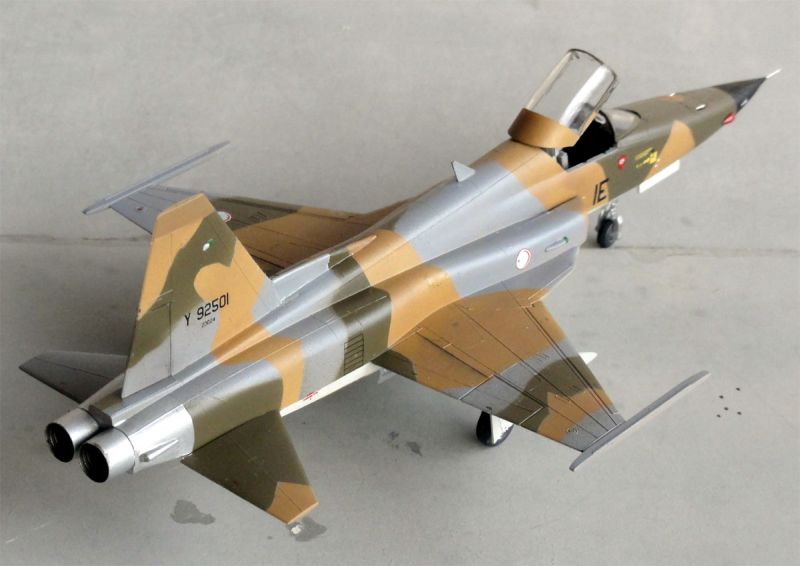[ page 7 ]
F-5 "Tigers" in 1/72 scale : kit modelling report
... continued from page 6...
F-5E TIGER
(16) F-5S Singapore
Again another Italeri kit #136 of the F-5E Tiger II was made for a by Singapore Aerospace upgraded F-5E of Singapore Air Force, now designated the F-5S. Some of these aircraft came from a canceled Morocco F-5E order and were in stead delivered to Singapore.
Milliverse decal sheet 72002 provides plenty of options for Singapore F-5E and S models. The instructions are complex but well researched and present you a lot of modelling options. (NOTE: some F-5 aircraft had originally the Shark "platipus" type nose).
I wanted to model a F-5S Tiger II of no.149 squadron with the Hill Grey scheme. It is an upgraded aircraft. Milliverse shows it in their decal instructions on page 4. It has a Grifo style radar nose, LONG LERX, with stencils as shown in option scheme "2". A possible F-5S a/c number is "834" as seen in 2000. It has a low visibility "Hill Grey" camouflage scheme.
In addition
the standard items are fitted as per Italeri kit:
(1)- front
nose RWR and aft RWR (kit parts #37 and #38, 39).
(2)- optional
are the lower Chaff flare dispensers aft of the main undercarriage bay
(kit parts #35, 36). These I fitted on this F-5S model to be made.
Some conversion
work for the F-5S was needed. These are here described in logical steps
as the model was made...
First the model
with fuselage and installing the wing and tail planes was assembled done
as per instructions. The Italeri kit used here had the pointy Tiger like
radar nose. (NOTE: some Singapore F-5E aircraft had originally the Shark
"platipus" type nose. If you want to model one of these, use the later
Italeri
released kit #1363 that
has an adapted wider platipus nose).
Next came for the F-5S:
(3)- adding a dorsal fin, made from thin card; this was blended in with putty and sanding.
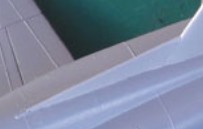
(4)- adding a long LERX, made from thin card added next to the intakes; blend in with some putty and sanding; Milliverse shows this as LERX type W6.

(5)- making
the adapted fuel tanks: the Singapore aircraft often have large central
fuel tanks. A larger tank was made from scrap using parts from the spares
box, "guesstimating" the size looking at photos and the Milliverse drawing.
Also, the shape of the fins are different of many fuel tanks; this was
adapted from thin card;
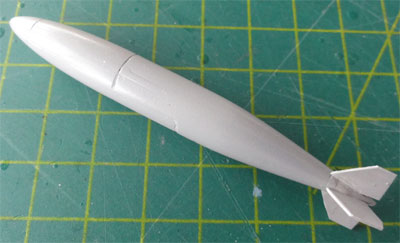
(6)- adding a refueling probe; this was made from a slightly adapted kit part #78 found in a ESCI F-5C Soshi Tiger kit #9038. It has "closed area" added in the fork (see Milliverse drawing) made from some plastic card.

It was painted with the brush the surrounding colour of FS 36375. Note that apparently 3 types of refuelling probes were used!
When the model was assembled (but still without gears and smaller antennas to make air brushing easier), a base grey coat was applied. Any irregularities were corrected with putty and sanding. Now the paint scheme could be applied.
The model was to be finished in the
"Hill Grey" scheme, so these acrylic colours were applied with
the airbrush:
- FS 36375 Light Ghost Grey using
Gunze Sangyo Mr Hobby H308 acrylic;
and after the previous colour dried
and some masking (including masking off the vertical tail)...
- aft fuselage section: FS 36320
Dark Ghost grey using Gunze Sangyo H307 ;
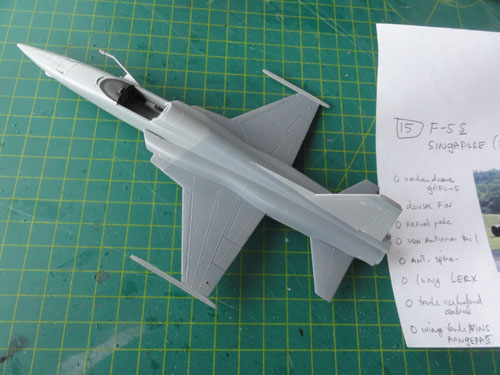
Do not forget to airbrush the adapted
stores like the tanks, gear doors and pylons as well. The exhaust area was also airbrushed
after masking in aluminium but the exhaust pipes got a bit darker paint.
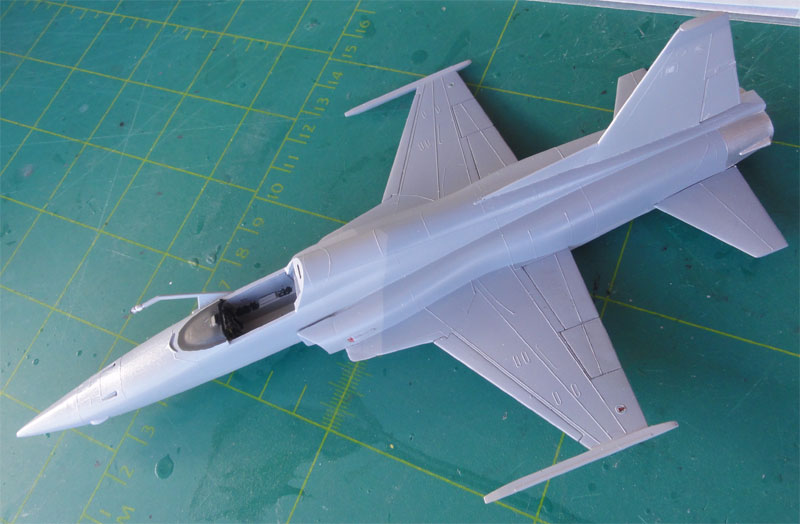
Some additional
detail work was done:
(7)- one canon is often fitted in the F-5S because of the radar equipment space; in that case so do not fit the port (left) canon barrel kit part #15; there is now probably here only a ventilation opening at this position. However I saw photos showing both canons and the newer nose, so 2 were installed. For each canon barrel I used a tiny bit of a metal needle in stead of the plastic kit part #15.
(8)- the Grifo radar nose can be fitted to later aircraft. Externally it looks a bit different: the F-5S has a new FIAR Grifo radar; the radar nose fiberglass section extends a bit more aft; I suggested this by painting the bigger nose area a slightly darker FS 36375 with a more aft re-positioned radar nose panel line.
Now I decalled the model. This is
a lot of work but nicely Milliverse provides you with HUNDREDS of smaller
stencils. Take your time here!
Ensure that decals are applied on the model
with a gloss undercoat, see my usual technique. These paints were already glossy but still I took no
risks.
The model is still rather grey'ish
but that's because it has a low visibility scheme.
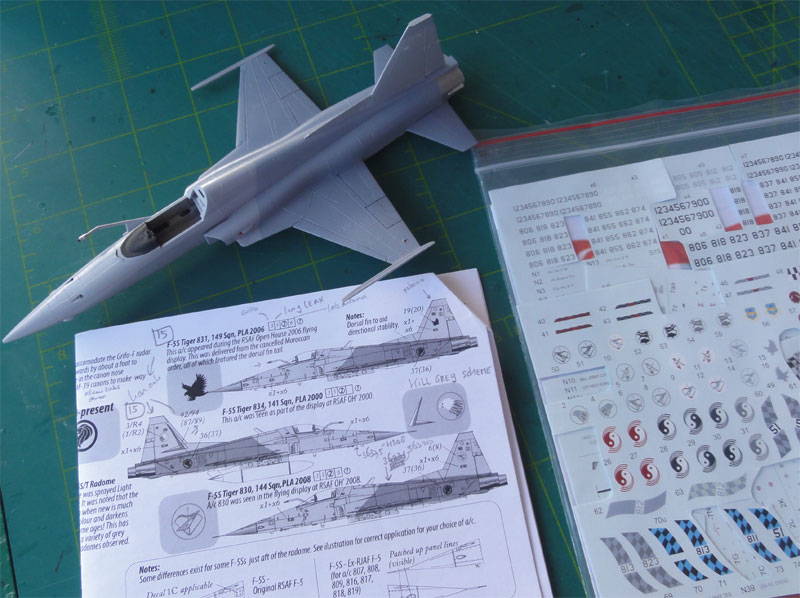
The undercarriage with doors and
so on were installed as per kit instructions.
Now time for remaining detailing F-5S model work to be done:
(9)- adding a large UHF antenna on the fuselage spine with also a tiny black antenna in front of that and aft of the canopy; made from card.
(10)- flat plated VOR/ILS antenna atop on the vertical tail; made from card and painted FS 36375 .
(11)- relocated smaller antenna aft of the nose gear bay and ILS antenna; note: this is described in the Milliverse instructions.
(12)- the canopy has a vent/slot in the hood at port (left) side; a decal #B1 is provided for this so I did not even try to cut in the slot in the clear brittle canopy!
(13)- the rather
standard angle of attack vane/indicator below the windscreen on starboard
(right) side was not seen on the photos; probably because the tank probe
is nearby. So I did not install kit part #49. But a small sensing probe
was added on the port lower side next to the nose gear bay made from a
metal piece of rod.
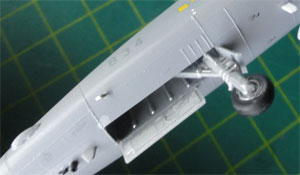
(14)- the arrestor hook part #32 was
painted white with black stripes added.
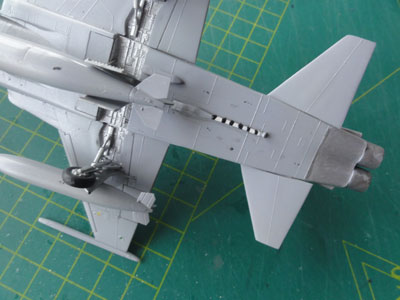
The F-5E canopy is good but has no detail inside and this is missing when set open. It was installed as described on previous F-5E models.... The canopy also got 2 tiny mirrors from etched metal.
The F-5E end finishing was also to replace the nose pitot with a bit of a metal needle and adding a few hydraulic lines from thin wire to the undercarriage gear legs. After all dried, a semi-matt dull coat was applied with Future with 5% Tamiya flat base mixed in. This gives an even sheen and looks good as well as protecting the decals for years to come.
I saw that often aircraft carry a
AIM-9J Sidewinder. I obtained one from Hasegawa Weapons set III that looked
good. This one was all medium ghost grey, painted and installed. The converted
central fuel tank was also set in place.
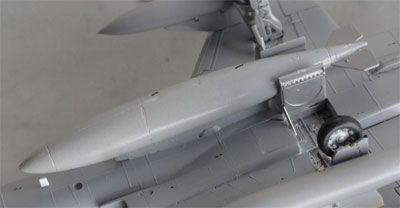
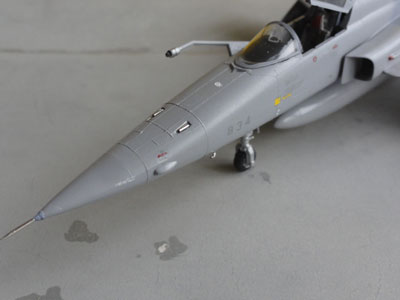
That completed the Singapore F-5S
model!
SINGAPORE 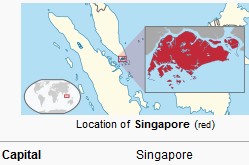 .
. ....
.... ..
..
[area: 728 km2 | population: 5,6 million | GDP USD 64,000 per capita nominal ]
Singapore is an island republic and became independent from Britain in 1963. The Singapore air defense command was established in 1968 and was renamed air force in 1975. Before that the defense relied on British forces. The first jet aircraft were Hawker Hunters delivered in the 1970s. Also BAC Strikemasters and A-4 Skyhawks followed in 1973. In 1980 the first F-5E Tigers with Sidewinders were acquired so Hunters could be transferred to a ground attack role. First came 18 F-5E and 3 F-5F trainers an before 1990 an additional 17 F-5E and 6 F-5F that also could be equipped with Maverick ground attack missiles. Aircraft flew from bases like Paya Lebar and Tengah. In the 1990s Singapore Aerospace converted 8 F-5E to the recon RF-5E and in 1994 and extra 7 second hand F-5E came from Jordan. Several system upgrades were done in the 2000s and 2010s with the introduction of a new FIAR radar in the slightly changed nose cone with one canon only and the now designated F-5S and F-5T can fire AMRAAMs.
The Singapore air force always acquired F-16 aircraft way back in 1988 followed later by many more advanced versions. Another important fighter type delivered from 2010 is the F-15SG Eagle. These replaced some of the F-5E.
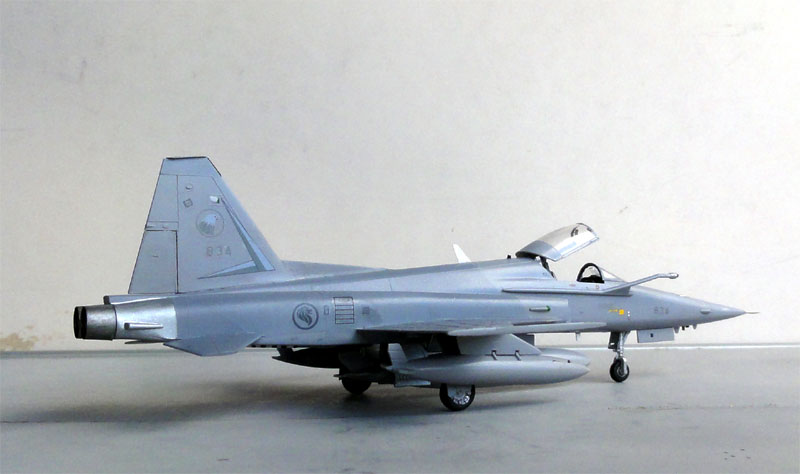
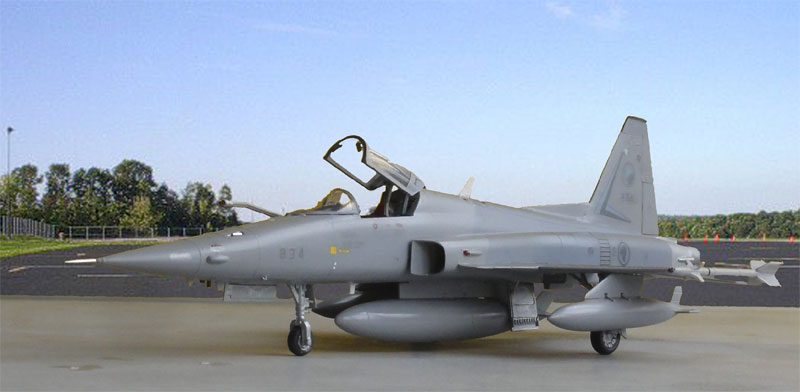
F-5S Tiger II of no.149 squadron SINGAPORE AIR FORCE
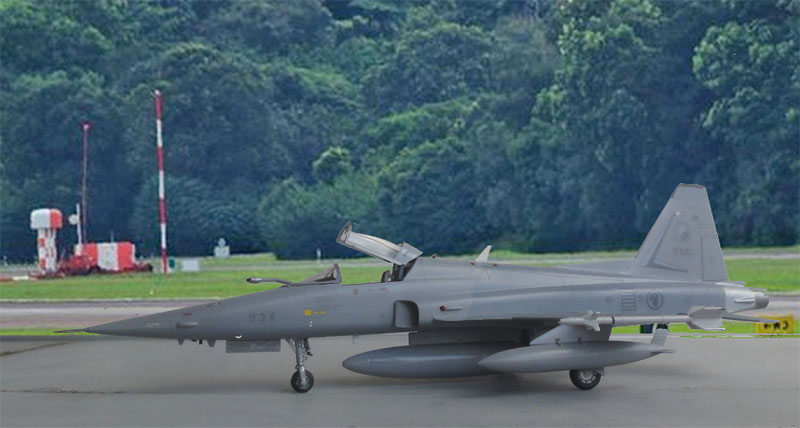
Neighbouring country Malaysia also operated the F-5E....
page 2
page 3
page 4
page 5
page 6
page 7
page 8
(14) F-5E Malaysia
Another Italeri kit #136 of the F-5E Tiger II was made, now in a Malaysian Air Force scheme. The kit #136 simply provides the decals though the stenciling is a bit simplified.
The kit was assembled as the previous Italeri F-5E kit(s) made seen on page 5...
The desired Malaysia F-5E scheme has an overall aluminium colour. I wanted also something special seeing a photo of an aircraft carrying a practice Dart under the port left wing.
The Dart was obtained from a 1/72 Hasegawa weapon set IV #X72-4. It has on the Malaysia F-5E a plain aluminium colour. Also, the cable pod in the set was used.
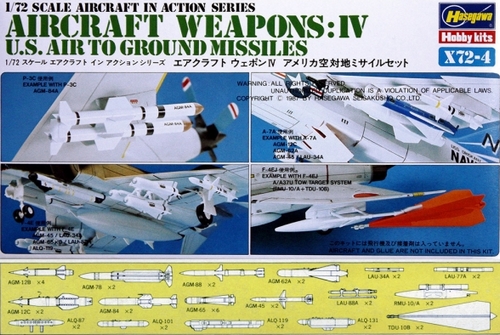
The kit was assembled as per instructions but I decided to droop down a bit the inner flaps. This was easy: just saw in with a razor saw the edges and bend them.
A little filler and sanding was needed at the tail fin leading edge and the nose section lower - upper joints. The model got a base light grey coat airbrushed on to check for any irregularities.
When that was OK, the Malaysia F-5E
overall aluminium colour was airbrushed using Vallejo 77.701 aluminium
coat

The smaller parts were not forgotten.
The remainder of the kit was assembled as usual. I saw no ECM fairings (parts #37 and #38, 39) on the Malaysia F-5E with Dart so these were not used. Also I noted that the intake Malaysia squared marking are a bit more positioned to the rear aft of the intake anti-collision light parts #16 (as opposed as shown in the Italeri scheme drawing).
Decals of Italeri are rather stubborn, thick and prone to silvering, so each decal was "dragged" through a Johnson Future/Pledge varnish bath to prevent "silvering". I had to "press some decals" when the Future dried a bit onto the model surface to stick the decal in place.
I also used some stencils from other
spare decal sets. The gaps for the lower lights aft the nose gear were
closed with white glue.
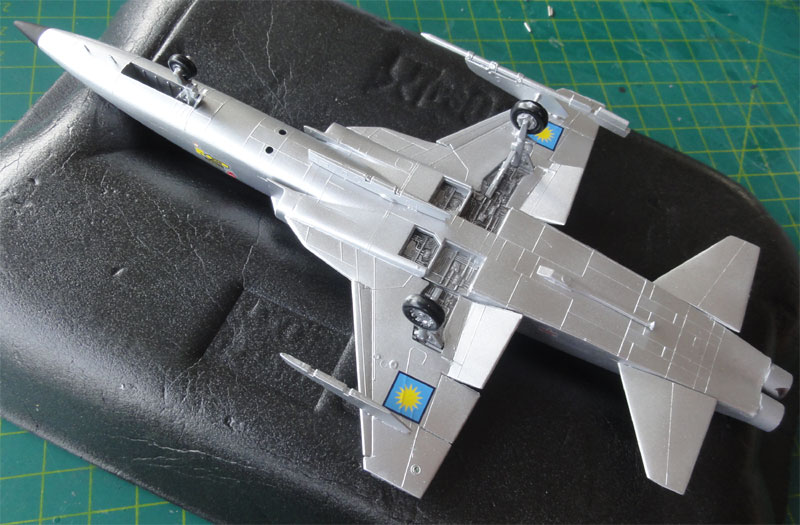
The installment of landing gear and
doors was done as per instructions. When setting the lower air brakes open,
add a few actuators from scrap. Also, the inside doors got each an actuator/rod.
The F-5E canopy is good but has no detail inside and this is missing when set open. It was detailed and installing as described on the previous F-5E models.... The canopy also got 2 tiny mirrors from etched metal.
The F-5E end finishing was also to replace the nose pitot with a bit of a metal needle and adding a few hydraulic lines from thin wire to the undercarriage gear legs.
The rather standard angle of attack vane/indicator below the windscreen on starboard (right) side was installed using kit part #49. Also a small sensing probe was added on the port lower side next to ehe nose gear bay made from a metal piece of rod.
The arrestor hook part #32 got 5 black stripes added.
The Dart installation was not very
clear. I used the kit pylon #46 and the Hasegawa set part for the Dart
boom but had to bend it a bit. The cable pod I positioned at the central
station. The cable running could not be clearly seen on photos, but I saw
a small fairing amidst the pod. It is probable that the pod can have the
cable leaving it at the rear or amidst as probable in this case. The cable
was made from thin fishing line, set in place with superglue.
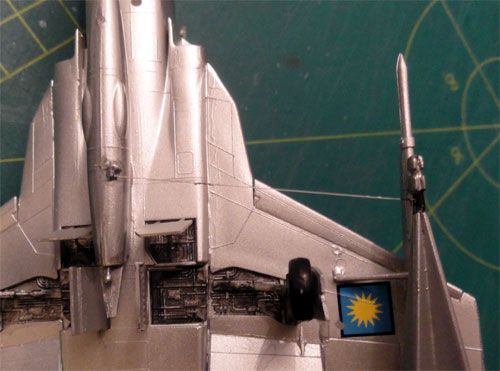
The Dart was installed with the wire
from fishing line as described.
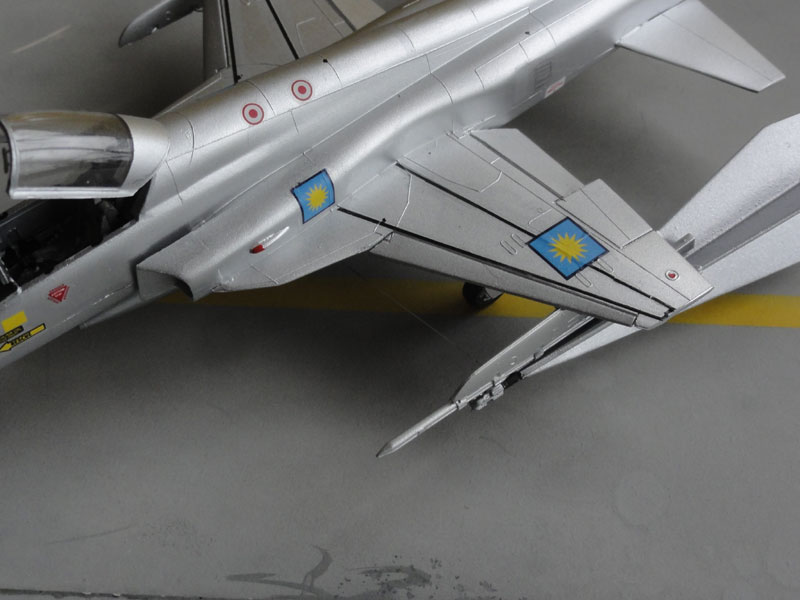
After all dried, a semi-matt dull coat was applied with Future with 5% Tamiya flat base mixed in. This gives an even sheen and looks good as well as protecting the decals for years to come. The canopy was set in place and that completed the model.
[ area: 330,800 km2 | population: 33 million | capital: Kuala Lumpur | GDP USD 10,000 per capita nominal ]
The Royal Malaysian
Air Force (RMAF; Malay: Tentera Udara DiRaja Malaysia (TUDM)) was established
June 1958 as the Royal Federation of Malaya Air Force (Tentera Udara Diraja
Persekutuan). But military aviation started earlier in the 1930s in the
than British Colony Malaya. The Malaysian Federation was formed September
1963 and gradually British forces left the country as well as Australia
from the base Butterworth. Twenty Canadian CL-41 Tebuens were acquired from 1967 and other aircraft used were types like the Caribou, Dart Herald
and S-61 helicopters. From Australia, CAC F-86 Sabres were received. Ex
US Navy A-4 Skyhawks were also acquired.
In 1982 the
first of 14 Northrop F-5E Tiger II arrived along
with a few F-5B trainers. These are locally designated M29. They were the first supersonic fighters, mostly
flying with no.12 squadron from the former Australian base Butterworth.
The Malaysian air force also ordered the reconnaissance RF-5E Tigereye
(2 aircraft). Eventually some 17 F-5E, 4 F-5F and 2 RF-5E were used.
The air force
has other modern aircraft as well of various origins: F/A-18 Hornets,
MiG-29, MB-339C, Sukhoi SU-30 and BAe Hawks. The air force also operates 4 Airbus
A400M large transports. Bases are Kuantan, Kuala Lumpur, Butterworth, Bukit
Lunchu, Ipoh and others like Kuching and Labuan at Borneo.
The F-5E's
are retired and put out of service.
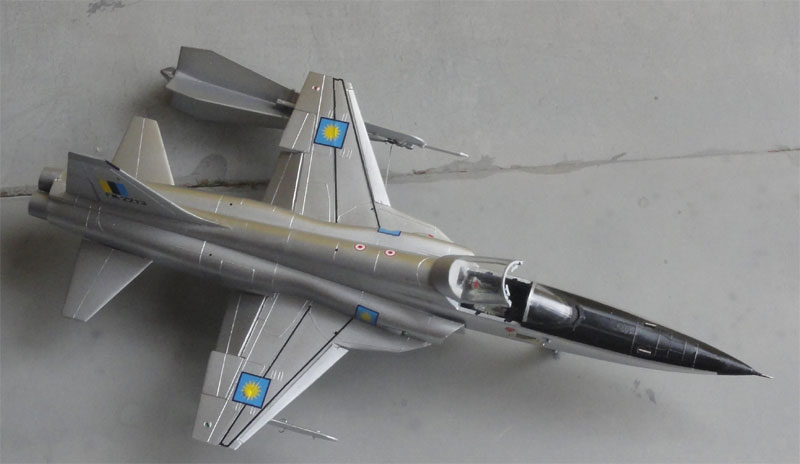
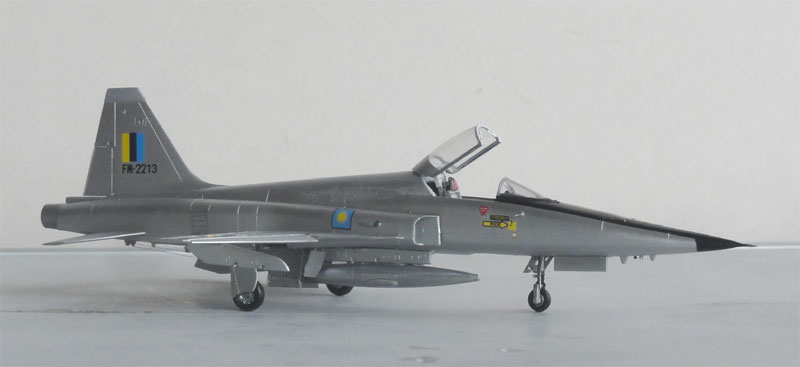
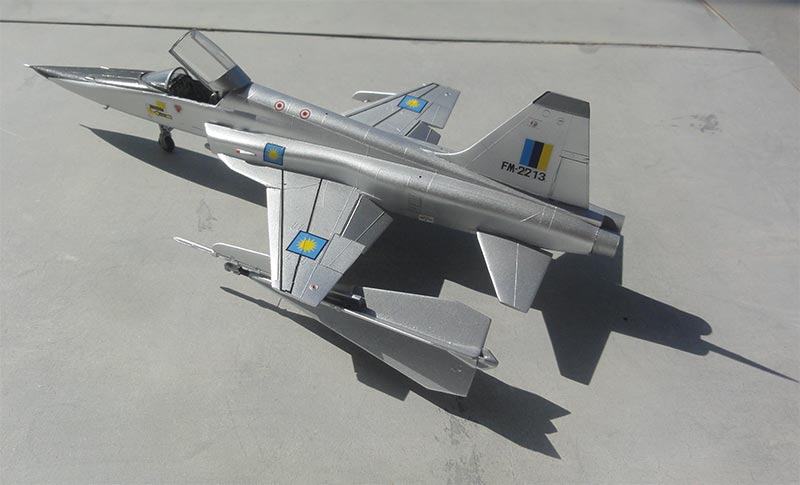
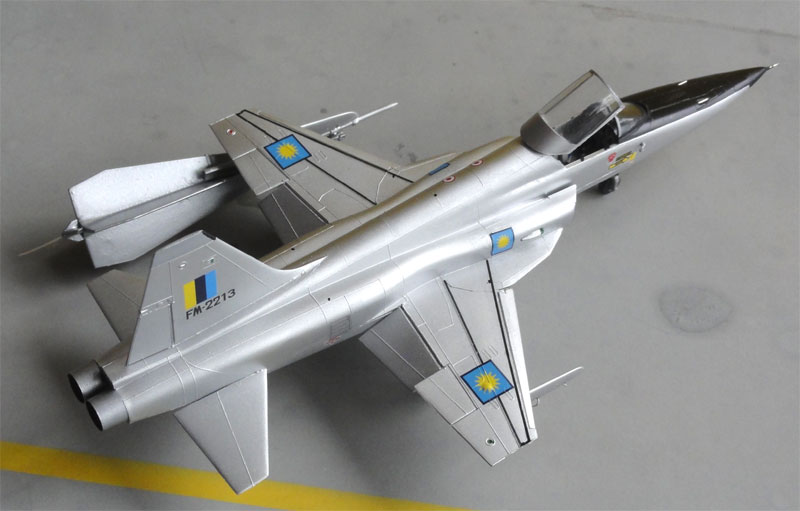
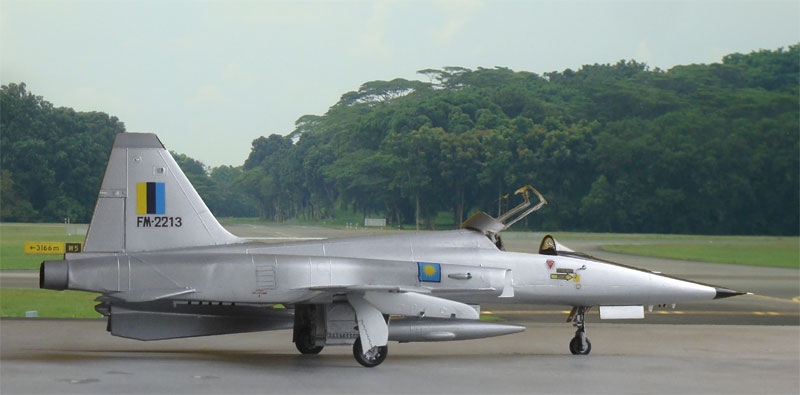
Malaysian
F-5E with training Dart
(15) F-5E Tunisia
Yep, another Italeri kit #136 of the F-5E Tiger II was made, now a camouflaged F-5E of Tunisia.
The decals are from the Carpena decal set 72.74 "F-5 International" that has some basic markings for it. The decals are very brittle so take care when applying these.
The kit was made as the other kits described earlier. The ECM parts as provided in the kit were used.
The acrylic colours applied with
the airbrush were in this order:
- first the lower surface FS 36622
using Gunze Sangyo Mr Hobby H311 ;
- ghost grey FS 36320 using Gunze
Sangyo H307 ;
- olive drab FS 34087 using Gunze
Sangyo H304 ;
- sand/tan about FS 30219 (indicated
FS 30400 seems to light). So I used Gunze Sangyo H310 ;
Each colour needed masking as the demarcations look rather "sharp". Masking was done with low tack tape and Revell masking film.
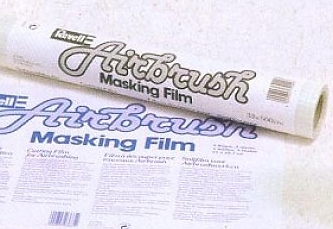
I forgot about
the dorsal antenna. So was added, better do it before painting
off course. It was made from thin card and "blended" in with the tail with
putty.
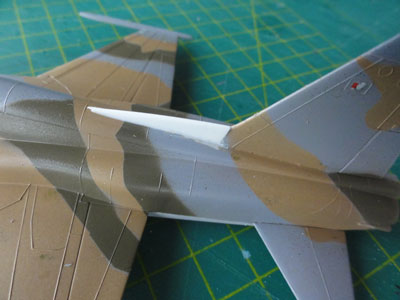
The exhaust area was brush painted in aluminium and the exhaust pipes got a bit darker burned metal paint. No anti-glare panel was seen in front of the windshield though.
Decals were applied on the model with a gloss undercoat with my usual technique. These CARPENA decals are very thin and vulnerable so be careful here!
The F-5E canopy of the kit is good but has no detail inside and this shows when set open. Some details were made as described on the previous models....
The nose ECM RWR fairings on the Tunisian F-5E aircraft sometimes have a red colour, I painted this for added interest. The rather standard angle of attack vane/indicator below the windscreen on starboard (right) side was installed using kit part #49. Also a small sensing probe was added on the port lower side next to the nose gear bay made from a metal piece of rod.
The F-5E end finishing was also to replace the nose pitot with a bit of a metal needle and adding a few hydraulic lines from thin wire to the undercarriage gear legs. The arrestor hook part #32 that was also light grey as the lower surfaces got 5 black stripes added with a fine paint brush.
After all dried, a semi-matt dull coat was applied with Future with 5% Tamiya flat base mixed in. This gives an even sheen and looks good as well as protecting the decals for years to come.
[area: 163,600 km2 | population: 11,8 million | capital: Tunis | GDP USD 3,700 per capita nominal ]
Tunesia in
North Africa with the Mediterranian was for many years a French Colony.
Tunesia regained independence in 1956 and 3 years later the "Al Quwwat al
Jawwiya al Jumhuriyal al Tunisiyah" (Republic of Tunisia Air Force / L'armee
de l'air Tunisienne ) was established. The president remained in power
for many years and was Western oriented and kept a neutral position in
the Arab world. Tunesia was supported with American aid and Italy. Aircraft
like Saab Safirs and in 1965 Aermachhi MB-326 aircraft were acquired and
from 1969 15 second hand ex-USAF F-86F Sabres. In the 1970s FS-260
Warrior trainers were received, flying from Sfax-Thyna.
From 1984 Tunisia
obtained about 8 F-5Es and 4 F-5Fs with in 1989 probably 5 extra F-5E from
the USAF. They are merely operated from the base Bizerte-Sidi Ahmed. From
1995 12 Aero L-59 armed trainers were acquired flying from Gafsa base.
There are also several transport aircraft like a few C-130, G-222 and Let-410.
From 2000 political unrest came in the country with different groups and
religion conflicts.
A total of
16 F-5E/F Tiger II aircraft remain in service in Tunisia with no.15 squadron
from Bizerte-Sidi Ahmed near Tunis and the coast. Since 2013, Tunisian
F-5s have been used in strike missions in support of major offensives in
the border region of Mount Chaambi against militants.

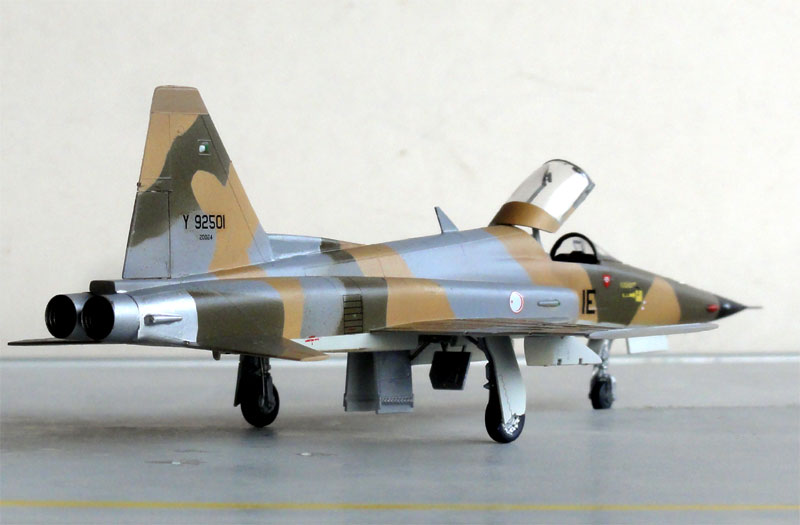
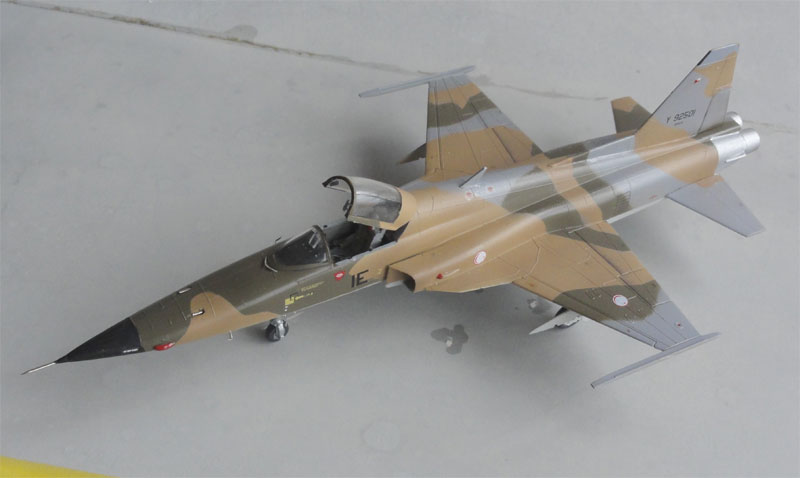
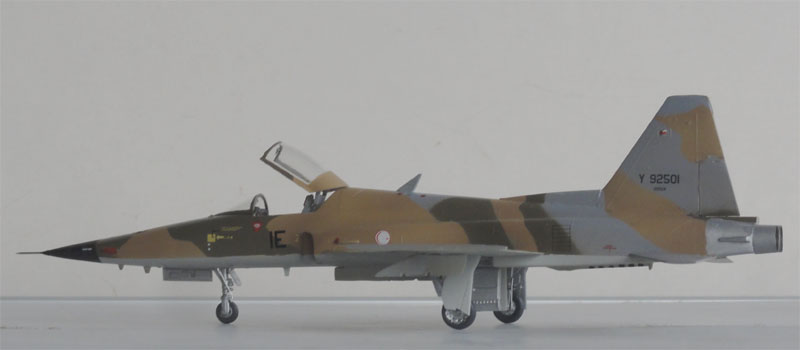
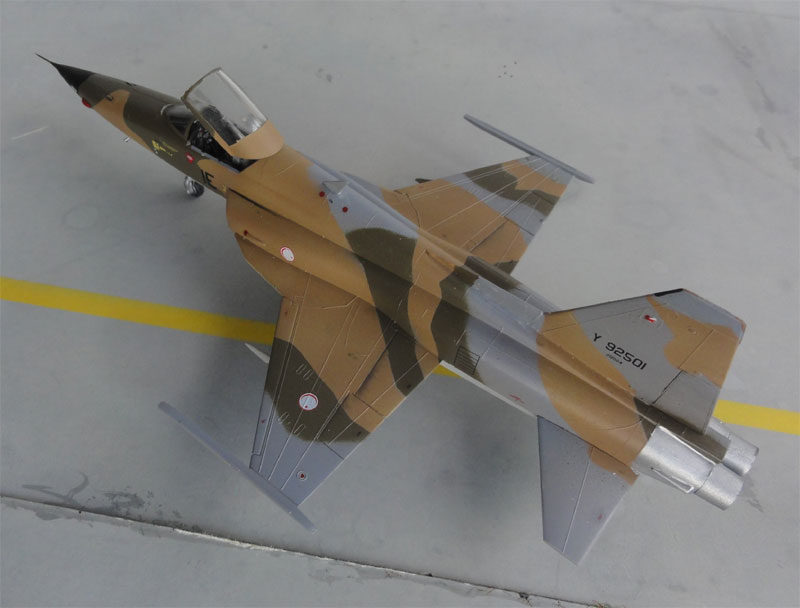
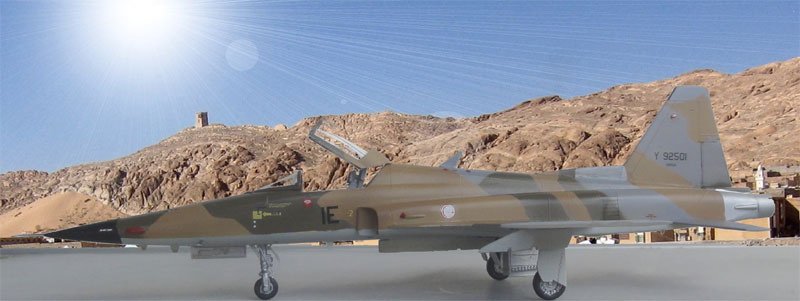
F-5E
of the "Al Quwwat al Jawwiya al Jumhuriyal al Tunisiyah" no.15 squadron
Back to 1/72 Models
(c) Copyright "designer"/ All rights reserved. Your comments are welcomed by webmaster
Created this page
November 10, 2017
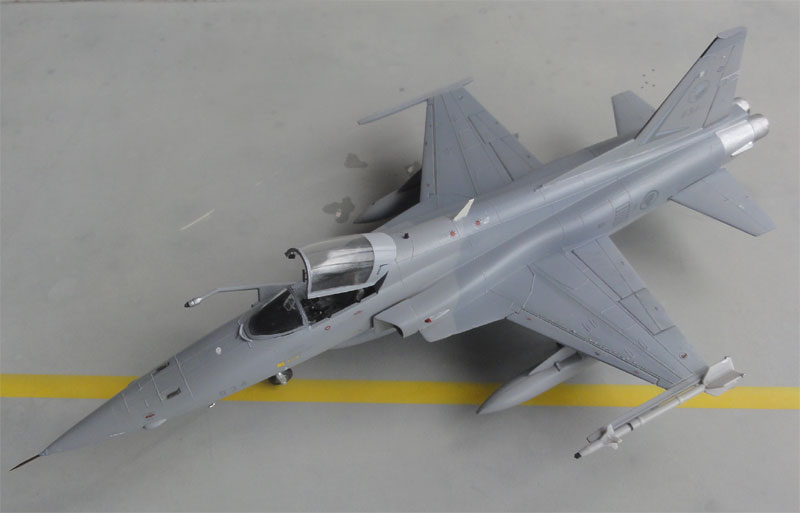

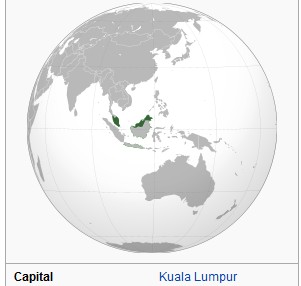 .
.
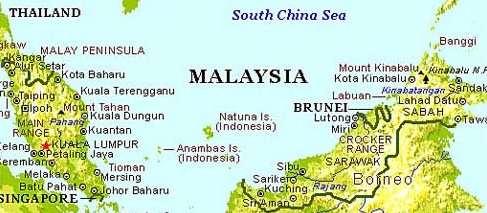 ..
..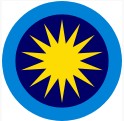 ...........
...........
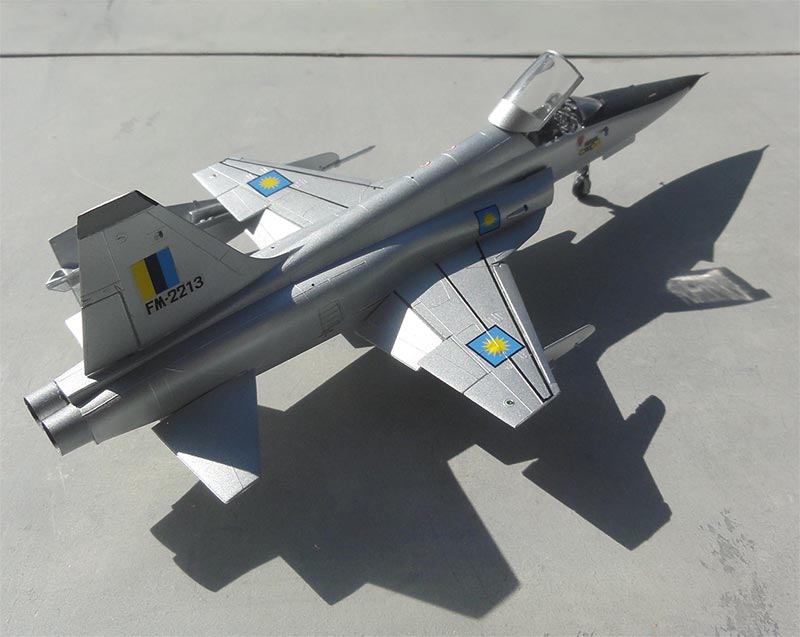
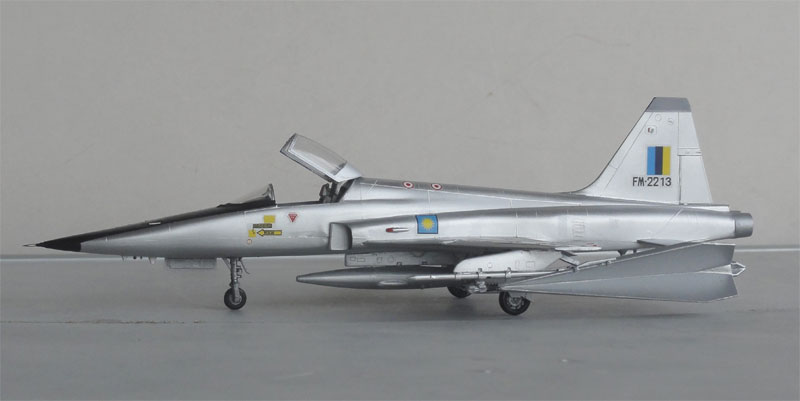
 .
. ....
....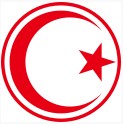 ........
........
